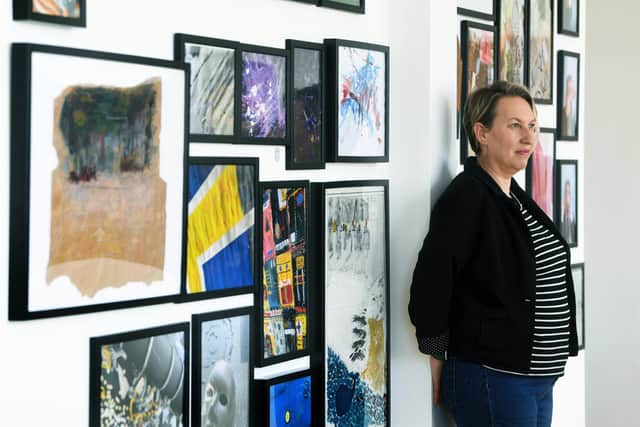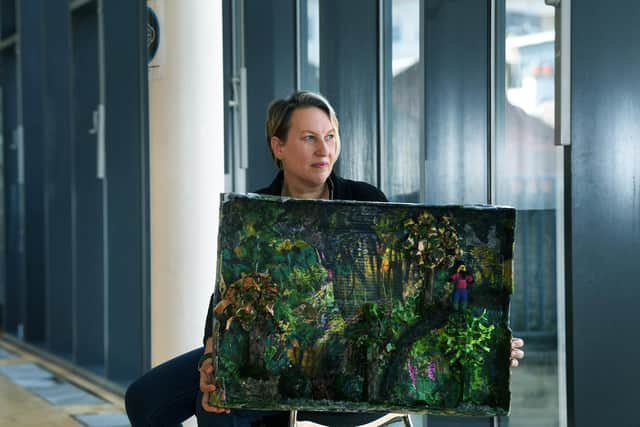Seeing music and hearing colour - Barnsley exhibition explores neurological condition connecting David Hockney and Lady Gaga
A fascinating new exhibition has opened at the Civic in Barnsley which explores the experiences of musicians and artists with chromesthesia, a type of synaesthesia where one sense blends with another. It means that people living with the condition will often experience a sense of colour when they listen to music and vice versa.
The Seeing Music, Hearing Colour project was initiated by Barnsley-based musician and composer Helen Madden, who is herself synaesthetic, and is part of the Civic’s No Boundaries programme which aims to amplify the voices and creativity of communities under-represented in the arts.
Advertisement
Hide AdAdvertisement
Hide Ad“I discovered I had synaesthesia when I was about 20,” says Madden. “I was listening to a piece of music by Debussy and I asked a friend whether he thought grey or green was the more prominent colour in the music as I was struggling to identify the shade.


"He looked at me with a blank face, he didn’t understand what I meant and that’s when I realised that not everyone heard music the way I did. I had never really discussed it with anyone before and it was quite a shock that this was something unusual.
“I started to do a bit of investigation at that point but it wasn’t as easy to find out things twenty odd years ago and the condition itself at that time wasn’t as well understood or researched. Since then, there has been a lot of work on brain-imaging so you can see what is happening in the brain when you are listening to music.”
As a musician, teacher and composer Madden says she had been interested in exploring synaesthesia in relation to music and visual art “for quite a while” and when some of her other projects were put on hold due to the Covid-19 pandemic she felt it was the right time to take it further. “I began exploring this idea a bit more – I had been talking to people with synaesthesia and I just thought it was a good opportunity to do it.”


Advertisement
Hide AdAdvertisement
Hide AdShe began by thinking of a piece of visual art that she could use as inspiration for creating some music. She had a Paul Klee painting in mind, Southern Gardens, as an initial prompt for her composition but then another artwork came her way. She was given a print of I Will Kiss You Forever, a painting by Robert Smith lead singer of The Cure, as a Mother’s Day gift.
“As soon as I saw it, I could hear the piece of music,” says Madden. “I thought it was very pertinent because Robert Smith has been a massive inspiration in my life. I first heard a saxophone on a piece of music by The Cure and that is what made me want to play the instrument.
"There were a couple of tracks in particular Close To Me and Disintegration. I was 15, learning piano and struggling with it a bit, bashing through the classical grades – and those tracks made me start thinking about the saxophone. So, using his picture seemed very appropriate.”
An accomplished multi-instrumentalist – she plays (and teaches) piano, saxophone, flute and clarinet – Madden created her composition in response to the image and then recorded it with five musicians she had worked with before.
Advertisement
Hide AdAdvertisement
Hide Ad“That was the first stage, then I sent the piece of music out to five visual artists with synaesthesia, without telling them which picture had inspired my soundscape, and I asked them the question ‘what do you see?’. I could hear reds and blues, greys and greens and I was curious to see if there was any correlation.”
The second stage of the project was engaging community groups in Barnsley to work with. “I have worked a lot in community music, so if I do a big project like this, I always want to involve people in the community,” says Madden. “I am really passionate about breaking down barriers – everyone should be entitled to make music and art even if they don’t have the training.”
She approached three local groups to help her with the next phase. “Creative Recovery is an organisation working with people recovering from mental health and addiction issues and they use art to help their recovery. Penistone Grammar School Heartspace Unit which focuses on mental health and wellbeing and Project 14 a mental health charity which supports people who have been bereaved by suicide.”
Madden played a recording of her composition to each group and they then created their own artwork in response to it. “I was interested to hear how people responded when I asked them if they ‘heard’ colours and if certain pitches suggested certain things. Following on from that they made other artworks of their own with the view that I would take the musicians in and with them they would compose their own music to go with their art pieces.
Advertisement
Hide AdAdvertisement
Hide Ad“They were really enthralled by the project and it was fascinating to work with them all. I loved listening to what they created musically – some are intricate soundscapes and others are really lovely pieces of music. With Creative Recovery we made a collaborative piece of music that ended up being more about community and nature rather than colour. That was lovely.”
The exhibition, curated by Madden and artist Chiomah Akanwa Dey, features the works by the artists they initially worked with and also all the artwork created by the community groups in the workshops.
It is recommended that visitors to the exhibition bring a pair of headphones with them as there are QR codes which connect you to the music that accompanies an artwork so that viewers can listen and try and match for themselves elements of the visual to the musical representation.
“The whole stimulus of the project was to explore colour and how people process colour,” says Madden. “What is important is that we have in effect explored a new artform with a lot of new people; we have thought a lot about it, we have been breaking down barriers and challenging tradition.
Advertisement
Hide AdAdvertisement
Hide Ad"And it has been so lovely to get messages from the participants about how it has enhanced their wellbeing. For some people art or music has always been something they have wanted to try and for some of the young people it has really boosted their confidence. Everybody worked really well together.”
For Madden it was very important that the participants felt that they had been involved in something that they could feel a sense of pride about. “A lot of thought went into the project and it turned out to be everything I wanted it to be – it was inclusive and they all said that they felt proud of what they had achieved
"That is exactly what I hoped they would feel. I think what we have been saying is – this is possible, you can do this and through it we have formed relationships that might continue. It has been wonderful bringing people together and giving them something new and meaningful. I am hoping this will be the start of other collaborations; It really has been quite a life-affirming project in a way.”
Seeing Music, Hearing Colour is at the Civic, Barnsley until June 9.
Advertisement
Hide AdAdvertisement
Hide AdSynaesthesia is a neurological condition that causes a blending of the senses – colours can be connected to letters and numbers, smells and tastes to music or touch to vision.
Synaesthesia has long been associated with creativity – famous synaesthetes include the artists David Hockney and Wassily Kandinsky, classical composers Franz Liszt and Jean Sibelius, musicians Duke Ellington and Billy Joel and more recently Pharrell Williams and Lady Gaga.
Synesthesia can occur between nearly any two senses or perceptual modes. Chromesthesia is the association of sounds or music with colours. For some it can be just everyday sounds for others musical notes or keys.
